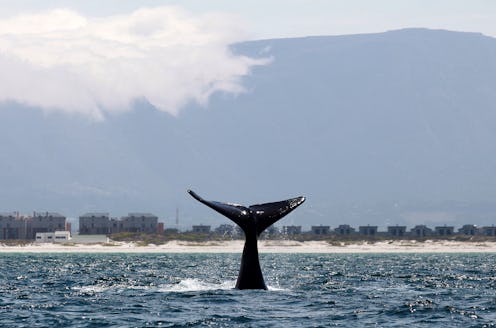News
These Whales Are Nearing Extinction
With oil drilling off the Gulf Coast imminent, federal regulators are seeking threatened or endangered status for a small population of Bryde's whales in the Gulf of Mexico, according to the Associated Press. Scientists guess that there are fewer than 50 of the whales left in the Gulf, and a recent stock assessment found roughly 15. The National Marine Fisheries Service announced in April that it might grant the small population of Bryde’s whales (pronounced Bru-dihs whales) threatened or endangered protection since a sliver of the eastern Gulf, near the whales' habitat, will soon be opened up for oil drilling, according to the AP.
The whales, a type of baleen whale, live about 70 miles off of the Florida panhandle in the DeSoto Canyon region, which is about 50 miles east of where the catastrophic BP oil spill happened 5 years ago. According to the AP, the Bryde's whales are found in tropical waters around the world, but scientists have deemed the population in the Gulf a genetically separate species from all the other Bryde's. The evaluation is great news for the Natural Resource Defense Council, who filed a petition last year seeking protection for the small population. Giulia CS Good Stefani, an NRDC attorney, called the Gulf of Mexico an "industrialized body of water," where the threats facing animals "are a perfect storm," according to the AP:
There are so few of these animals left there is no doubt that they are at risk of extinction. They really are down to the last individuals.
Stefani said that some of the threats whales face in the Gulf are being struck by ships or disrupted and killed by oil and gas activities gone wrong. Even seismic tests for oil, which use loud air guns and have already been planned in the Atlantic for the first time in 26 years, can hurt the whales' hearing and ability to communicate and affect their normal behavior, according to National Geographic.
The Marine Mammal Protection Act makes it illegal to "intentionally harm" the whales, but granting them threatened or endangered status would provide more objective, concrete protection in the long term. Threatened or endangered protections can include an established, critical habitat for the whales and a plan to recover their population. Most importantly, the whales' conservation would have to be considered more carefully by the Interior Department before issuing oil drilling permits. John Hildebrand, a whale specialist at the Scripps Institution of Oceanography at the University of California-San Diego, told the AP:
Whenever you have a species down in their tens, it's spooky in terms of their long-term survival.
Scientists have also speculated that Bryde's whales may have lived in other portions of the Gulf, but they were driven out by offshore oil and gas drilling off the coasts of Louisiana and Texas starting in the 1950s. The whales don't make long migrations, so once they like to stay wherever they are as long as possible, according to the AP. The blue whale, finback whale, humpback whale, sei whale, and sperm whale have all been listed as endangered since 1970. Of those whales, Hildebrand told the AP only sperm whales can be found in larger numbers in the Gulf — a recent assessment found about 1,665 of them.
Unfortunately, accidents from oil drilling have had dangerous effects on whales in the Gulf. After the BP oil spill, scientists found concentrations of chromium and nickel in the carcasses of sperm and Bryde's whales that were five times higher than the global average, according to Pacific Standard. These are two of the only chemicals where there is a world-wide consensus that they can cause cancer. The chemicals can impair reproduction in whales and stop their calves from developing normally, Pacific Standard reported.
Image: Getty Images (2)
